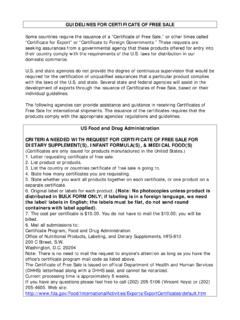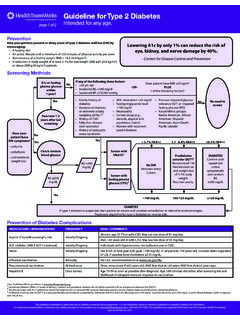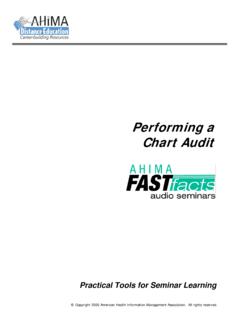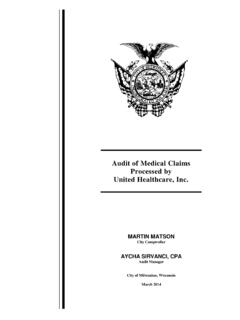Transcription of Evaluation and Management (E&M) Audit Form …
1 8/11/2016 Page 1 Evaluation and Management (E&M) Audit form Colorado Workers Compensation Exhibit #7 Injured Worker Name:_____ New or Established Patient, Date of Injury __/__/__ E&M Provider s Name: _____ Reviewing/Paying Insurer Name: _____ Place of Service: Office, Hospital, Freestanding facility, ERD, Other_____ Date of Service__/__/__ Billed E&M CPT code: _____ Audited E&M Level code: _____ Chief Complaint (required): _____ Medical necessity of the visit must be identifiable somewhere within the written report. Did the documentation meet the Consultation Criteria Required in Rule 18? 1. Is who requested the consultation in the report? Yes or No 2. Does the report contain one of the following reasons for a consultation: a.
2 A specified diagnosis confirmation b. Symptom Evaluation /diagnosis by a specialist c. Evaluation for acceptance of patients ongoing care for a specified condition or problem 3. The consultant s report was submitted to the requesting provider a s a: a. C arbon Copy (CC); or b. Addressed directly to the requesting provider c. Not identified at all Medical Documentation Guidelines Used for this Audit : Exhibit #7 to Rule 18, (effective__/__/____) using either: (circle either a. or b.) a. Three Key Components, or b. Counseling/Coordination of Care was > 50% of Visit Medicare s 1997 E/M Documentation Guidelines (Requires a different appropriate 1997 Documentation Audit Template) 8/11/2016 Page 2 Exhibit #7 Relevant History Key Component History of Present Illness (HPI) Review of Systems(ROS) Past, Family, Social History (Check Applicable 1-4 types of hxs documented ) Location: _____ Constitutional symptoms Patient current and past medical Quality: _____ Eyes Current medications Severity: _____ Ears, Nose, Mouth, Throat Prior illnesses Duration: _____ Cardiovascular Operations and hospitalization Timing: _____ Respiratory Allergies Context: _____ Gastrointestinal Injuries Modifying factors.
3 _____ Musculoskeletal Family Associated signs: _____ Integument Parents, siblings, etc. Neurological Hereditary disease(s) Total # of HPIs___ Psychiatric Diseases related Endocrine Social Hematologic/lymphatic Living arrangements Allergic/Immunologic Marital Status married, single, divorced Genitourinary Sexual history Use of drugs, alcohol, or tobacco Total # of ROSs:___ Current and/or past physical activities Current and/or past hobbies Patient s emotional support system Identified issues for RTW or Tx Plan Occupational Currently working or not Review of past job history Past occupational history Education Total # of Hxs.
4 __ History Elements Requirements for a Problem Focused (PF) History Level Requirements for an Expanded Problem Focused (EPF) History Level Requirements for a Detailed (D) History Level Requirements for a Comprehensive (C) History Level History of Present Illness/Injury (HPI) Brief 1-3 elements Brief 1-3 elements Extended 4+ elements (Initial visits require(s) an injury causation statement and or an objective functional goal treatment plan. Follow-up visits require objective functional gains/losses, ADLs etc) Extended 4+ elements (requires a detailed patient specific description of the patient s progress with the current TX plan, which should include objective functional gains/losses, ADLs) (Initial visits require(s) an injury causation statement and or an objective functional goal treatment plan.)
5 Follow-up visits require objective functional gains/losses, ADLs or RTW ) Review of Systems (ROS) is not required for established patient visits. None Problem pertinent limited to injured body part 2 to 9 body parts or body systems Complete 10+ Past Medical, Family and Social and Occupational History (PMFSOH) None None Pertinent 1 of 4 types of histories 2 or more of the 4 types of histories Was an objective functional goal present in the documentation? Yes__ or No__ Was there an assessment of any functional gains or losses? Yes__ or No__ 8/11/2016 Page 3 Exhibit #7 Documented Pertinent and Injury Related Examination Key Component Constitutional Measurements: any three (3) = 1 bullet Musculoskeletal Separate Body Areas: Sitting or standing B/P Head and/or neck Supine B/P Spine or ribs and pelvis or all three Pulse rate and regularity Right upper extremity (shoulder, elbow, wrist, entire and) Respirations Left upper extremity Temperature Right lower extremity Height Left lower extremity Weight Weight or BMI Total # of three (3) constitutional measurements:___ One Bullet for any three (3) Musculoskeletal Assessments of a given body area includes.
6 Inspection, percussion, and/or palpation with notation of any misalignment, asymmetry, crepitation, defects, tenderness, masses or effusions Assessment of range of motion with notation of any pain (eg straight leg raising) crepitation or contractures Assessment of stability with notation of any dislocation (luxation), subluxation or laxity Assessment of muscle strength and tone (eg flaccide, cog wheel, spastic) with notation of any atrophy or abnormal movements (Fasciculation, tardive dyskinesia. Total # of Separate Body areas with three (3) or more musculoskeletal assessments performed:____ Examination of Gait and Station = One (1) bullet One bullet for commenting on the general appearance of patient if not addressed under neuro or psychiatric (development, nutrition, body habitus, deformities, attention to grooming).)
7 Neck: one bullet for both examinations Neck exam ( masses, overall appearance, symmetry, tracheal position, crepitus) Thyroid exam (enlargement, tenderness, mass) Neurological: One bullet for each neurological exam/assessments per extremity R leg and or L Leg and R Arm and L Arm Test coordination ( , finger/nose, heel/knee/shin, rapid alternating movements in the upper and lower extremities UE Unilateral or Bilateral: and or LE Unilateral or Bilateral -Examination of deep tendon reflexes and/or nerve stretch test with notation of pathological reflexes ( , Babinski) UE Unilateral or Bilateral; and or LE Unilateral or Bilateral Examination of sensation ( , by touch, pin, vibration, proprioception) One (1) bullet for all of the 12 cranial nerves assessments with notations of any deficits Cardiovascular One (1) bullet per extremity examination/assessment of peripheral vascular system by: Observation ( , swelling, varicosities).)
8 And Palpation ( , pulses, temperature, edema, tenderness) One (1) bullet for palpation of heart ( , location, size, thrills) One (1) bullet for auscultation of heart with notation of abnormal sounds and murmurs One (1) bullet for examination of each of the following: carotid arteries ( , pulse amplitude, bruits) abdominal aorta ( , size, bruits) femoral arteries ( , pulse amplitude, bruits) Skin One (1) bullet for pertinent body part(s) inspection and/or palpation of skin and subcutaneous tissue ( , scars, rashes, lesions, cafeau-lait pots, ulcers) Respiratory (one (1) bullet for each examination/assessment) Assessment of respiratory effort ( , intercostal retractions, use of accessory muscles, diaphragmatic movement) Percussion of chest ( , dullness, flatness, hyperresonance) Palpation of chest ( , tactile fremitus) Auscultation of lungs ( , breath sounds, adventitious sounds, rubs) Gastrointestinal (one (1) bullet for each examination /assessment)
9 Examination of abdomen with notation of presence of masses or tenderness and liver and spleen Examination of presence or absence of hernia Examination (when indicated) of anus, perineum and rectum, including sphincter tone, present of hemorrhoids, rectal masses and/or obtain stool sample of occult blood test when indicated Psychiatric One (1) bullet for assessment of mood and affect ( , depression, anxiety, agitation) if not counted under the Neurological system One (1) bullet for a mental status examination which includes: Attention span and concentration; and Language ( , naming objects, repeating phrases, spontaneous speech) orientation to time, place and person; and Recent and remote memory; and Fund of knowledge ( , awareness of current events, past history, vocabulary) Eyes One (1) bullet for both eyes and all three (3) examinations/assessments Inspection of conjunctivae and lids; and Examination of pupils and irises ( , reaction of light and accommodation, size and symmetry).
10 And Opthalmoscopic examination of optic discs ( , size, C/D ratio, appearance) and posterior segments ( , vessel changes, exudates, hemorrhages) 8/11/2016 Page 4 Ears and Nose, Mouth and Throat One (1) bullet for all of the following examination/assessment: External inspection of ears and nose ( , overall appearance, scars, lesions, asses) Otoscopic examination of external auditory canals and tympanic membranes Assessment of hearing with tuning fork and clinical speech reception thresholds ( , whispered voice, finger rub, tuning fork) One (1) bullet for all of the following examinations/assessments: Inspection of nasal mucosa, septum and turbinates Inspection of lips, teeth and gums Examination of oropharynx: oral mucosa, salivary glands, hard and soft palates, tongue, tonsils and posterior pharynx ( , asymmetry, lesions, hydration of mucosal surfaces) Genitourinary MALE One (1) bullet for each of the following examination of the male genitalia.



















